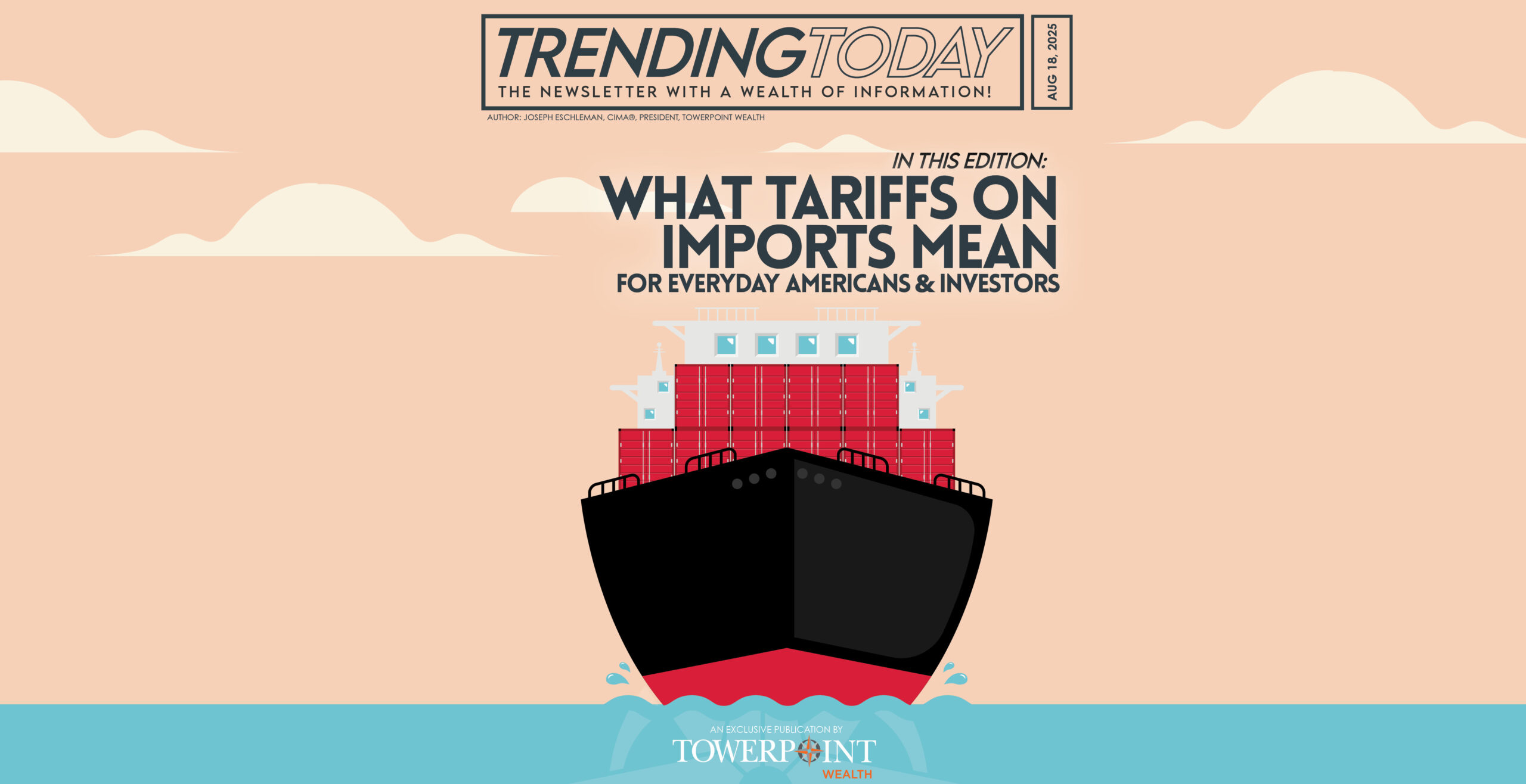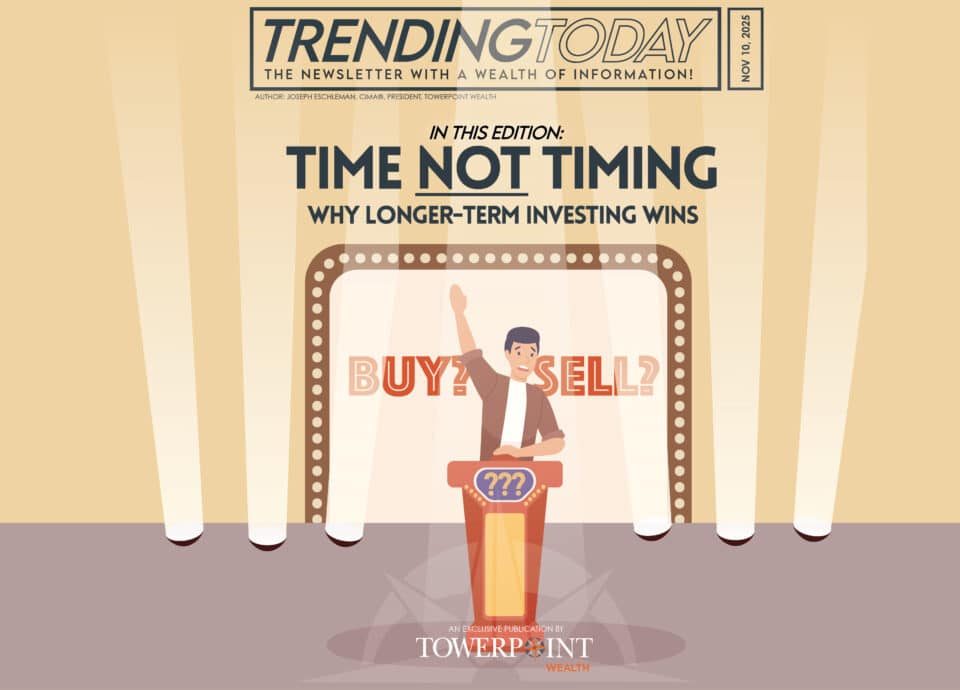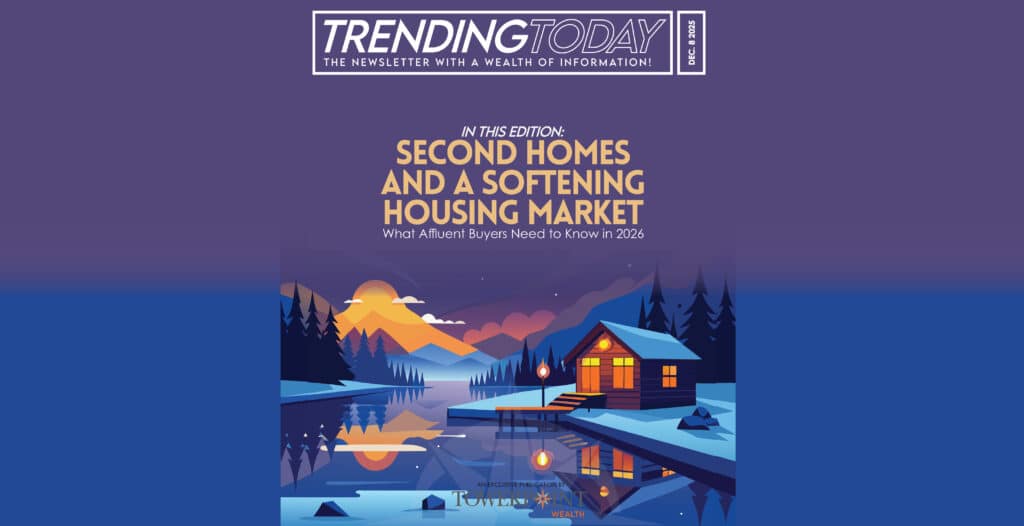It’s official. As of this month, tariffs on imports are officially in effect — and while that may sound like a headline for economists or politicians, the reality may hit much closer to home.
These new trade measures are more than numbers on a policy sheet. They can affect what you pay at the store, the price of your next car or appliance, and even the value of your investment portfolio. When tariffs on imports from the EU, China, and other countries are implemented, businesses can face higher costs, which sometimes can be passed along to consumers.
This moment is significant because it’s not just about the goods being taxed — it’s about the broader tariffs’ impact on the U.S. economy. From everyday households to longer-term investors, the ripple effects can influence spending habits, inflation, market volatility, and overall financial confidence.
At Towerpoint Wealth, we believe that staying informed is the first step toward making sound financial decisions. That’s why we’re breaking down what’s changing, how tariffs in effect can influence both your wallet and your investments, and how proactive planning can help you navigate an uncertain trade environment.
Whether you’re a consumer noticing higher prices or an investor wondering how this shift might affect your portfolio, the goal here is simple: cut through the noise and focus on what matters most for your financial life.
Key Takeaways
- Some economists believe that new tariffs on imports are increasing the cost of a wide range of goods, from electronics to everyday household items.
- These tariffs can create ripple effects in the economy, including potentially higher inflation and shifting corporate earnings.
- Consumers may see price increases in common purchases, which can impact household budgets.
- Investors should expect shorter-term market volatility and sector-specific impacts as companies adjust to higher costs.
- Proactive financial planning can help individuals and families adapt to the changing economic environment and take advantage of opportunities.
What’s Changing: The Scope of the New Tariffs
U.S. tariffs on imports are now firmly in effect, and the changes are sweeping — impacting a wide range of everyday goods from electronics and vehicles to clothing and appliances. Reports show that tariffs on items like electronics, home appliances, furniture, and toys are driving up prices, with increases already showing in inflation data.
In particular, tariffs on imports from China remain a major driver of these cost spikes. Products such as laptops, smartphones, and other electronics that rely heavily on Chinese components are seeing notable price increases. Industry analysts warn that these tariffs will likely amplify production costs and strain inventory planning.
The ripple effects extend into supply chains, too. With tariffs on Chinese imports climbing, manufacturers are being forced to relocate sourcing — shifting production lines to countries like Vietnam, India, and the UAE — to stay cost-competitive.
The tariffs we see in effect today are not isolated lines in policy documents — they’re increasing costs on consumer goods, squeezing business margins, and sparking strategic shifts in global supply chains. It’s a tangible moment in trade policy, with real effects for households and investors alike.
How Do Tariffs Impact the Economy?
When tariffs impact the economy, it’s rarely a straightforward transaction — instead, they set off a ripple effect across consumers, businesses, and markets.
First, businesses face higher costs when the government imposes tariffs on imports. These costs often get passed down to consumers. Retailers such as Adidas and Walmart have also announced that prices on electronics and appliances will increase as a result of these tariffs.
The broader consequence can be inflationary pressure. When prices climb, consumers feel the pinch immediately. Wall Street economists warn that these tariffs are triggering what’s being described as stagflation‑lite — a mix of slowing growth and rising prices.
From a market perspective, corporate earnings and investor sentiment can sour. Tariffs can boost input costs, squeezing profit margins unless companies pass costs along or sacrifice earnings. Investor confidence can waver, especially when the macroeconomic outlook grows murkier.
Put simply, here’s how tariffs impact everyday economic life:
- You may pay more for everyday purchases.
- Inflation can creep higher, especially in essentials.
- Businesses navigate tighter margins and uncertain policymaking.
- Investors respond with caution, which can pull markets lower.
At Towerpoint Wealth, we believe that understanding how tariffs impact the economy is essential to managing financial plans that endure. When you’re budgeting for rising costs or adjusting your portfolio to evolving conditions, awareness and adaptability are key.
What Tariffs Mean for Households
When tariffs impact the economy, the effects don’t just show up in corporate earnings reports — they show up on your grocery receipt, your utility bill, and your next online order.
Economists estimate that the latest round of tariffs could add approximately $2.400 per year in additional costs for the average U.S. household. While that number may seem manageable in isolation, the reality is that higher prices are showing up across multiple categories at once, amplifying the strain on budgets.
Consumer goods seeing some of the steepest increases include:
- Electronics like smartphones, laptops, and household appliances.
- Clothing, shoes, and sporting goods.
- Furniture and home improvement products.
- Certain grocery staples, especially imported packaged goods.
The burden is felt most heavily by lower- and middle-income households, where a larger share of income is spent on everyday essentials. For these families, even modest price increases can require trade-offs — postponing purchases, cutting back on discretionary spending, or dipping into savings.
At Towerpoint Wealth, we believe that preparing for the ways tariffs impact your personal finances is just as important as understanding the broader economic picture. By building flexibility into your spending plan and investment strategy, you can adapt without sacrificing long-term goals — even when costs are on the rise.
Tariffs and the Markets
The effects of tariffs on international trade are rarely confined to trade alone — they oftentimes ripple through the stock market, bond market, and global investment landscape.
In the short term, tariffs often create market volatility. Investors react quickly to headlines, pricing in the potential for higher costs, slower global growth, and changing corporate profit margins. This can lead to sharp swings, particularly in sectors most directly affected by tariffs on imports such as consumer electronics, automotive, and retail.
At the same time, certain industries may benefit from tariffs.
Domestic manufacturers that compete with imported goods can see a relative boost in demand, as can companies in sectors like defense, infrastructure, or alternative manufacturing hubs outside China. Commodities, especially those tied to industrial production and energy, may also see price movements as supply chains shift.
One important consideration for investors is that tariffs often influence inflation expectations.
Higher costs for goods can feed into broader inflationary pressures, which in turn affect Federal Reserve policy on interest rates. This creates a chain reaction — higher inflation expectations lead to potential rate hikes, which can lead to changes in bond yields and borrowing costs.
For longer-term investors, these dynamics open both risks and opportunities:
- Risks: Slower earnings growth for import-heavy companies, potential pressure on consumer spending, and geopolitical uncertainty.
- Opportunities: Defensive sectors like utilities and healthcare, commodity exposure, and companies poised to benefit from supply-chain diversification.
At Towerpoint, we view the effects of tariffs on international trade not as a single event to react to, but as part of a broader, ongoing shift in global trade relationships.
By staying disciplined, diversifying across sectors and geographies, and aligning your portfolio with your longer-term personal and financial objectives, you can weather shorter-term “tariff turbulence” while positioning for structural changes ahead.
How Have Tariffs Affected Inflation So Far?
There’s no shortage of headlines about the tariffs now in effect — and many focus on the potential for rising prices and economic strain.
But, as is often the case, the real picture is more nuanced. While tariffs can influence certain sectors and goods, the broader economy and markets have shown resilience. In fact, there are several reasons why tariffs haven’t driven widespread inflation the way some feared:
- Muted consumer price impact – Many tariffs have been absorbed by importers and manufacturers through tighter profit margins, operational efficiencies, and shifting supply chains, preventing a direct pass-through to shoppers.
- Global sourcing flexibility – Businesses have diversified production, sourcing from tariff-exempt countries or negotiating better trade agreements, offsetting potential cost increases.
- Currency effects – A stronger U.S. dollar during much of the tariff period has reduced the cost of imported goods, helping counterbalance some of the tariff-related price hikes.
- Market focus on fundamentals – Equity markets have largely been driven by corporate earnings, innovation, and labor market strength rather than short-term trade disruptions.
- Confidence in policy response – Investors have operated with the belief that central banks and fiscal authorities would intervene to soften any significant economic drag from tariffs, creating a backstop that has kept risk appetite steady.
This doesn’t mean tariffs are without consequence — but it’s a reminder that economic cause-and-effect is rarely simple, and that thoughtful, long-term planning matters more than reacting to headlines.
Planning Through Policy Uncertainty
With tariffs in effect, the financial landscape is shifting — sometimes subtly, sometimes dramatically.
Trade policies can change quickly, and the tariffs impact we’re seeing today may look different a year from now. That’s why successful investors don’t typically dramatically react to the news cycle; they prepare for multiple possibilities.
At Towerpoint Wealth, we incorporate policy uncertainty into our fiduciary planning process. That means stress-testing your portfolio and your cash flow plan under different inflation and tariff scenarios — from modest, short-lived price increases to prolonged cost pressures across the economy. We evaluate how various sectors, asset classes, and income sources could respond, and position your strategy to adapt without derailing your long-term goals.
Our role is to help you stay disciplined in the face of unpredictable headlines. Whether the latest tariffs on imports lead to shorter-term volatility, higher inflation, or new investment opportunities, we ensure your plan is built to absorb the shocks — and take advantage of the openings.
Final Thoughts
Tariffs are in effect, and their influence can be felt across both the checkout counter and the investment markets. Higher projected prices on imported goods are changing household budgets, while ripple effects in corporate earnings, inflation, and investor sentiment can reshape opportunities — and risks — for portfolios.
The reality is that you can’t control trade policy, but you can control how prepared you are. A thoughtful, proactive plan helps you navigate the uncertainty, minimize surprises, and keep your financial goals on track regardless of where the next headline takes us.
If you’re wondering how the current tariffs on imports may affect your investments, retirement plan, or day-to-day finances, we invite you to take the next step.
Schedule a 20-minute “Ask Anything” conversation with the Towerpoint Wealth team, and let’s review your plan in the context of today’s economic realities — so you’re ready for whatever comes next.







